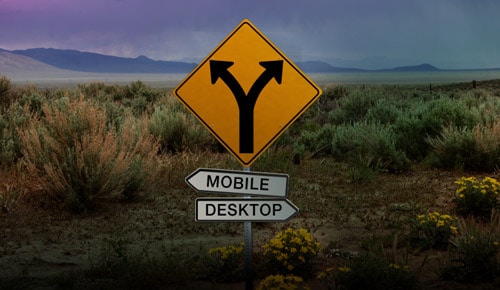Responsive vs mobile website design
In 2011 it was predicted that mobile internet usage would overtake desktop internet usage by 2014 and in January this year, that expectation came to fruition with mobile devices accounting for 55% of internet usage in the USA.

Conscious of this fact, more and more of our clients ask us how to ensure their new or revamped website is mobile user friendly.
There are essentially two options available:
1. A mobile website
A mobile website is a site designed specifically to be accessed on mobile devices such as smartphones and tablets. (When required) a redirect code sends visitors from your regular website to your mobile site.
Mobile site – Pros
- Greater functionality as it is purpose-built
- Good for eCommerce sites as the website can be clutter free with large call-to-action (BUY NOW!) buttons (serving a specific purpose).
Mobile site – Cons
- Requires the development of a second site at additional cost
- May not be as functional or offer all options available on your full website.
2. A responsive website design
A responsive site is one which basically adapts to its user. It shrinks and grows based on the browser size, so can be used on desktop computers, laptops and mobile devices.
Responsive site – Pros
- It is Google’s preferred configuration
- Only one site is required, so costs less than building two separate sites.
Responsive site – Cons
- Not as flexible as a purpose-built mobile site
- More expensive to build a site with well-functioning responsiveness.
3. A native App
Ha! Tricked you there with a sneaky third option. Many of us use Apps on our mobile devices every day. Some are better than others, but the better ones offer good examples of their benefits.
It should be noted though there are extensive guidelines for Google Play, Apple App Store and so forth, so it’s good to know what you’re getting into before you start.
Of course an App does however allow users a more personalised experience. So while it may be expensive to build from scratch, if you’ve got the sort of business that demands it or would benefit from an App, it’s a third alternative you may want to consider.
Q: What does all of this mean?
A: There’s no easy answer.
The solution will vary from organisation to organisation and depends on a number of factors, most of which we touched on above:
- Cost
- Timing
- SEO and search-ability
- Browser support
- Functionality – both yours and those of your visitors. Do you want to sell online? Will visitors be needing to locate you when they’re out and about? What sort of information do they need?
- Your existing situation. If you’re about to build a whole new site, then responsive design can kill two birds with one stone; but if you’re happy with your current website, a separate mobile site may be for you.
Ultimately the decision is yours but knowing the pros and cons of all options should make the choice a bit easier.

